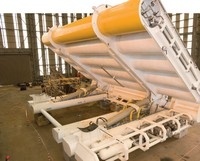Energy Shortlist

OYSTER
Aquamarine Power andQueen’s University, Belfast
With interest in renewable energy growing steadily, Aquamarine Power’s waveenergy converter, Oyster, has come along at the right time. The Edinburgh-based company worked with Trevor Whittaker, who heads a wavepower research group at Queen’s University Belfast (QUB), to design the device, which combines technologies from more conventional waveenergy devices with hydroelectric power.
The Oyster is a hinged flap that, unlike most wave-energy devices, is attached to the seabed, about 10m down, rather than floating on the surface.

When waves roll over the flap, it moves up and down, driving hydraulic pistons to send highpressure water via a pipeline to an onshore turbine. The design is simple, low-cost and robust, the company says, and as it is located near to the shore in fairly shallow water, it is accessible and easier to maintain than deepwater converters. Aquamarine envisages the device being deployed in farms generating
100MW or more. The first smallscale test device is being installed at the European Marine Energy Centre in Orkney, where tests are expected to begin this year. The results of these will be used to design the full-scale commercial Oyster II device.
Register now to continue reading
Thanks for visiting The Engineer. You’ve now reached your monthly limit of news stories. Register for free to unlock unlimited access to all of our news coverage, as well as premium content including opinion, in-depth features and special reports.
Benefits of registering
-
In-depth insights and coverage of key emerging trends
-
Unrestricted access to special reports throughout the year
-
Daily technology news delivered straight to your inbox










Water Sector Talent Exodus Could Cripple The Sector
Well let´s do a little experiment. My last (10.4.25) half-yearly water/waste water bill from Severn Trent was £98.29. How much does not-for-profit Dŵr...